How to choose a life raft? That is the question we answered in Part I of this series (“Choosing a Life raft,” March 2007). For Part II, we conducted a series of tests that mirrored those carried out by the U.S. Coast Guard and other certifying agencies. We asked manufacturers to send us six-man life rafts that they thought best suited a serious offshore sailor seeking a SOLAS life raft or its recreational equivalent. Six manufacturers responded to our request, sending a total of eight six-man life rafts: the 6-SOLAS from Elliot, the Switlik MD-3, the DSB ISAF, the Switlik SAR-6 MKII; the Viking RescYou (UKL), the Viking RescYou Pro (UKSL), the Winslow Ocean Rescue; and the Zodiac Class Ocean ISAF life raft. As it turned out, the life raft testers faced the very difficult task of distinguishing the best life rafts for cruising sailors among an outstanding field of entries.
***
288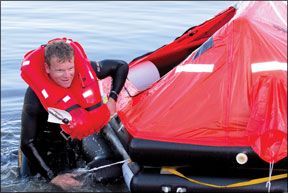
In our last life raft test (“Life Rafts Revisited,” Jan. 15, 2003), the Winslow Ocean Rescue was our favorite, and the Viking RescYou Pro earned Best Buy honors. However, in March 2005, the International Organization for Standardization (ISO) finally released its specifications for two types of recreational life raft—coastal and offshore—including minimum fabric breaking strength and tear strength. These are the manufacturing standards that life-raft makers, particularly those who make or market rafts in the European Union, are strongly encouraged to meet.
The International Sailing Federation (ISAF), the body responsible for the safety rules and recommendations that govern most major racing events, has incorporated the ISO fabric specs into its own life-raft standards for ISAF Category 1 (offshore) and Category 2 (coastal) races. The ISAF life-raft standards include many other additional requirements—covering everything from canister signage to external illumination. For $20, you can download the 2006-2007 ISAF Special Regulations, which cover life rafts as well as a wide range of offshore safety recommendations, at www.ussailing.org/safety/isaf.htm.
While the ISAF’s new benchmarks are yielding life rafts that are well-suited for small and mid-sized yachts, there remains a yet more rigorous life raft standard. The Safety of Life at Sea (SOLAS) standard, which applies to life rafts used by commercial ships, sets a higher mark in many key areas such as a fabric weight and inflation capacity. It is no surprise that SOLAS rafts are the only rafts allowed for “extreme” ISAF Category 0 races. Trouble is, the smallest SOLAS canister-packed rafts can weigh well over 100 pounds, making launching a difficult ordeal for one person. (A valise and modified survival pack can greatly reduce a SOLAS raft’s weight.) Part I of this series (March 2007) goes into greater detail on life raft standards and selection, and anyone considering buying a raft should read that article. Next month in Part III, we will look at the survival gear that accompanied the rafts in this test.
What We Tested
288
We asked manufacturers to send us six-man life rafts that they thought best suited a serious offshore sailor who is seeking a SOLAS-grade life raft or its recreational equivalent. Our testers expected that by getting a look at the top-of-the-line life rafts, they would also gain some insight into other life rafts in each maker’s line.
Ultimately, six manufacturers responded to our request, sending a total of eight six-man life rafts: the 6-ISAF from German company DSB; the 6-SOLAS from Elliot, a brand that is owned by the Ireland-based company RFD Beaufort and made in Ohio; the MD-3 and the SAR-6 MKII life rafts from the American family-owned company Switlik; the RescYou (UKL) and Viking Resc-
YouPro from the Danish company Viking; the Ocean Rescue from the American company Winslow; and the Class Ocean ISAF raft from the French inflatable boat giant Zodiac. New ISAF rafts from Winslow, Plastimo, and West Marine are on the horizon, and we intend to test them. We are also hoping to look at rafts from Revere and Givens—two companies who declined our test this time. It cannot be over-emphasized that all of these rafts in our test are very good, and each one would serve well on a cruising boat. Our testers faced the very difficult task of distinguishing the equivalent of magna cum laudes among a field of top-ranked Harvard grads.
DSB 6-ISAF
The design focus behind the DSB raft was to make a compact, self-righting, light, ISAF-approved raft that would have significant appeal to offshore racers as well as to cruisers with limited space. The lightweight butyl rubber material meets ISO tear and breaking strength standards, and the simplicity of the folded-corner, rectangular design increases stress at these points but keeps seam gluing or welding to a minimum. Vacuum packing further diminishes the size of the package.
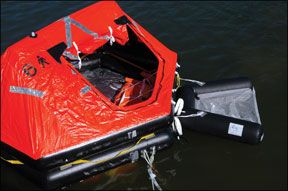
288
The DSB was the lightest raft tested, and it carried full ISAF approval. The lightweight, cored canister adds appeal for racers. The boarding step is not inflatable. This approach is better than just a webbing ladder, but when it comes to heaving a tired or semiconscious victim inside, an inflatable platform ramp wins handsdown. A ladder inside the DSB (a feature found on other rafts in the test) helps the first victim climb into the raft. The fact that a crew member must go out and right any of these rafts underscores the importance of a functional boarding aid. In the view of our testers, the DSB struck a fair compromise between boarding ease for a fit crew and minimal bulk when stowed.
By design, the DSB raft has a thin weak-link cordage spliced to the bitter end of the painter. The assumption is that this line will part should the mothership sink while the raft is still secured to it. Testers believed there is a chance that the user would ignore the light line and secure the raft with the thicker painter. Practical Sailor suggested relocating the weak link to the life raft end of the painter, as do other life rafts in the test. DSB is looking into changing this setup.
Bottom Line: For price-wary sailors who value a compact, light ISAF life raft, the DSB is Recommended.
Elliot 6-solas
All it takes is one look at how a SOLAS raft inflates to get the idea that there’s something different about this subset of rafts. The large gas cylinder caused the Elliot to spring to life with the tubes and canopy fully inflated in 6 seconds. The pressure relief valves hissed, bleeding off lots of excess volume, promising that if it were 20 or 30 degrees colder, this raft would still be full. In the raft was a full SOLAS A survival kit with water, flares, and food. The downside to all this extra gear is this was the only raft our fit, agile raft launcher couldn’t simply pick up and toss in the water. To launch the raft, which weighed in at 167 pounds, we simulated a deck-mount location and pushed the raft into the water.
The access was good, and the inflatable boarding ramp superb. The Elliot had a downward zipping closure, which some feel is less desirable than a zipper that you can incrementally close from the bottom to keep waves out, yet still let air in. Testers found that the zipper could be adjusted so that one top corner could be left open for watchkeeping and ventilation in heavy weather.
Another great debate looms over inflatable floors versus foil-coated foam. The Elliot possessed a nice rendition of the latter, and to its credit, the floor is fully functional upon deployment. Inflatable floor advocates point to its additional thermal protection.
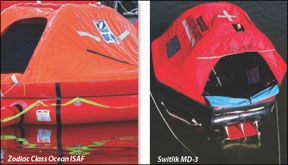
288
The heavy-duty nature of SOLAS rafts became clear as we measured tube skin thickness, checked stitching and seams, and noted little extras like a mechanical joint on the arch tube to help it endure physical punishment and better isolate it from the main buoyancy tube’s air supply.
Bottom Line: Rugged construction, superior inflation, and key details make this our Best Choice. A good price is a bonus. To cut weight, you could have it valise-packed and replace the SOLAS A-Pack with an E-Pack, supplemented with an overboard kit packed separately. Canister-mounting the full SOLAS version deserves careful thought.
Viking RescYou
Viking has stayed on top of the evolving ISO/ISAF standards with both of the rafts it submitted for our testing. Both rafts are also certified by Det Norke Veritas, an independent safety certification agency based in Norway.
This nicely proportioned, offshore raft from Viking has a rectangular footprint and a canopy that is well supported by a single-arch tube. The inflatable tubes and bottom of the raft are made of a durable composition of nylon coated with natural rubber. All three testers commented on the raft’s unpleasant odor—a tinge of tire-tube rubber—something not noted among the other rafts.
The raft’s inflatable floor had a comfortable air-mattress-like quality that kept occupants above the small amounts of water that collected on the raft bottom and could easily be sponged out.
During testing, the raft was easy to handle and launch. The painter pull-to-inflate test worked perfectly, requiring only about 10 pounds of line tension. The raft was fast to inflate. The canopy was full, and the pressure relief valve was hissing within 20 seconds. In January, Viking recalled some of these rafts, reporting that the Thanner & Co. pressure relief valve could fail, preventing the raft from inflating (www.vikng-yachting.com). The valve on our raft worked flawlessly.

288
Like all inflatable floors, it had to be manually inflated with an easy-to-operate hand pump. The canopy cover’s low profile configuration affords less windage and surface area for larger breaking waves to impact, and its shape is more like a SOLAS configuration than the larger canopy on the RescYou Pro. The seams, line attachment points, corners, and other areas were well reinforced, and extra layers of material were used where needed.
Boarding was expedited by a single large opening, one that allowed a person to easily drop into the raft or for a person in the raft to assist others into the raft. The entry seemed to be the right compromise, allowing room for boarding assistance without creating too much area for a breaking wave to tear open the zipper and invade the raft. The semi-circle inflatable boarding aid (shaped like a half donut) was not as easy to use as larger inflatable-platform-type boarding aids, but it proved to be a less vulnerable protrusion once the crew was settled on board.
Bottom Line: Details like the single arch put this raft a notch below the more expensive life rafts in our group, but the RescYou performed well and has a good overall structure. When you roll pricing and product quality into the equation, this Viking looks very appealing.
Viking RescYou Pro
This high-profile raft is designed to self-right if initially inflated upside down. Anyone with a tendency toward claustrophobia will appreciate the spacious, Conestoga-wagon-like canopy. In tropical latitudes, the extra canopy height affords better ventilation, especially with its two openings. However, the canopy also exposes more surface area to high winds and impact from waves than do other low-windage rafts.
Like the smaller Viking RescYou, the RescYou Pro is made of natural rubber-coated nylon, a strong, durable material with the same tire-tube smell of the smaller Viking life raft. Flotation tubes are black, although four bright orange ballast bags on the bottom will help make the life raft more visible if it capsizes.
Reflective tape is found on the canopy and tube sides, but none was placed on the bottom of this raft. Whether a raft is right-side up or upside down, it needs to be as visible as possible. At night, reflective tape is worth its weight in gold and a big cross on the bottom of the raft may be the only thing a helicopter or ship’s crew is likely see.
When Practical Sailor presented its preliminary findings for fact checking, Viking said that although the raft is designed so that it would not inflate in an inverted position, the company would be adding reflective tape to these rafts, a commendable and encouraging response.
Bottom Line: Price and solid construction qualify the Viking RescYou Pro as a good buy in the ISAF/ISO category.
Switlik MD-3
288
Switlik provided two of its high-end rafts for testing. One was a prototype of its new MD-3, which had undergone some jump testing prior to our receiving it.
Both were built using heavy-duty, 16-ounce, urethane-coated fabric (inside and outside the tubes) that meets commercial raft specs. Seams are overlapped and double-taped. The bright orange/red canopy on both rafts was slightly more visible in lower light situations than other raft canopies.
The smaller of Switlik’s two rafts was the new MD-3, a well-conceived evolution of the MD-2 that satisfies ISO as well as ISAF regulations, and is approved for Category 1 and 2 races. The lower profile, low-windage MD-3 has two openings and a rigid boarding step that improves access to the raft, but our testers concluded that this was still not as convenient as the inflated platforms found in other life rafts. Although Practical Sailor testers preferred a well-proportioned inflatable step, the trade-off of this approach is worth noting: Although they make boarding easy, an inflatable step—particularly a large one—exposes more surface area to waves and is more likely to interfere with flotation tube integrity.
We liked the fact that the MD-3’s two arches are each independent from the main tubes and each equipped with an entirely separate inflation system, a reliable way to ensure flotation tubes stay inflated should the arch tube be compromised. (Other rafts in our test rely on valves and independent flotation tubes to ensure that the raft will continue floating if the arch is damaged.) Add to this the heavy-duty fabric and strong seam structure, and you can see why our evaluation team kept using the terms “rugged and durable” to describe the Switlik approach to life raft construction.
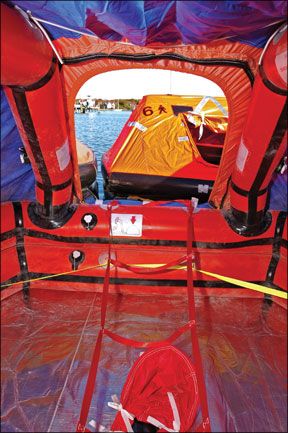
288
In keeping with its theme of protecting the crew from the sea, the MD-3 had smaller openings than the other rafts. This proved to offer better protection, but made it harder to board the raft. One of the zippers failed during the test, and it left one side of a two-zipper port open. Switlik’s post-test analysis noted that the zipper’s terminus on this prototype raft was higher than the other three, making it more vulnerable. The company will be lowering this zipper in its production rafts. The incident reiterates the Practical Sailor testers’ recommendation that all rafts have some other reliable means of keeping entries closed in case of zipper failure. Switlik says the smaller YKK zippers on the MD-3 were chosen to meet the ISO standard for waterproofness and to reduce the likelihood of snagging material. Still, our testers unanimously preferred the larger, smoother-sliding zippers on the SAR-6 MKII.
Once manually inflated, the MD-3’s drop-stitch inflatable floor is nicely designed to prevent water pooling. After inflation, it provides relatively firm, dry insulation from the sea. During deployment, the arch tubes seemed to get stuck and did not pop up for 4 minutes. One of the big pluses of the MD-3’s
design—the independent gas supply and inflation system for the arch tubes—contributed to this shortfall. Had a crew member climbed into the raft or pulled on the boarding ladder just after inflation of the hull tubes, the arches probably would have sprung free sooner. Testers felt that keeping the arch tubes isolated from the main hull tube air supply was enough of an asset to justify the slower arch tube inflation.
Bottom Line: A ruggedly constructed, low-profile raft that will appeal to those who want an inflatable floor and like a belt-and-braces approach to arch tubes.
Switlik SAR-6 MKII
288
Here’s a capable offshore raft with significant appeal to cruisers under power or sail. It evolved from the SAR-6-TSD-MKI, which the U.S. Coast Guard originally selected to be its standard air-droppable life raft. Many features developed for this function also make it a good choice for cruisers headed far afield. The raft’s large diameter, twin independent tube structure may seem standard issue, but one look at the convertible canopy top and the Toroidal Stability Device (TSD) lets you know that this raft has some unique, positive attributes.
Our fit, agile raft deployer struggled some with the 134-pound canister, but the molded handholds in each corner helped. Once deployed, the raft seemed “glued to the water” and resisted being tipped, towed or turned over more than any of the other rafts tested. The raft deploys with only the side portions of the canopy in place. This makes boarding a very easy process, but it puts the raft out of compliance for
offshore racing under ISAF Category 1 and Category 2 rules.
Zipping up the overhead and closing up the side openings is not prohibitively complex, but coping with these details at night on a gale-swept sea may take a bit of trial-and-error. The zippers used on the SAR-6 raft are larger than those found on the MD-3. They worked smoothly, have Velcro seal flaps on the overhead, and were easy to operate.
The Switlik SAR-6’s painter exits the canister through a hole about 2-inches in diameter that allowed flooding water. A the end of the 30-minute interval between launch and inflation, most of the canister’s initial buoyancy was gone. This life raft has long been certified to pass the 30-minute test, and indeed it inflated flawlessly in 14 seconds with a manual tug on the painter. Practical Sailor strongly recommends manual deployment, but we would still like to see more manufacturers building lightweight, cored canisters that would add a larger margin of reserve buoyancy. The amount of buoyancy should be more than sufficient to ensure autoinflation in extreme conditions (unlike our calm-water test). This cored-type construction would also add strength to the canister.
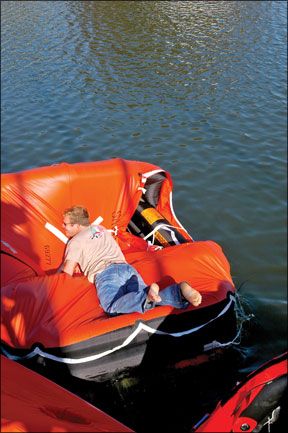
288
Bottom Line: The Switlik SAR-6 MKII’s stability, rugged construction and special features set it apart from others in its class, earning our Recommendation.
Winslow Ocean Rescue
We tested a slightly modified version of the winner of our last life raft test. The raft’s large tube diameter and 22 inches of freeboard, along with its 10-sided, nearly round shape, allow a crew to occupy equal dimensions while still facing each other, which can be a psychological advantage.
Testers were impressed by many of the relatively large raft’s features, but the tether arrangement drew concern. The webbing-style painter uses a threaded mechanical connector to insure a seal as it penetrates the vacuum bag in which the life raft is stored. This fitting was finger tightened and unscrewed easily. (According to Winslow, the finger-tight torque is normal and ensures a superior air-tight seal.) Other vacuum-packed rafts in our tests achieved good seals without introducing a threaded union in the painter.
On Winslow Ocean Rescue rafts without floating boarding aids, the painter is attached to the webbing ladder, which spreads the load to three attachment points on the raft. On models with inflatable ramps like the one on our test life raft, the painter is attached to only one of the three support points. The tow test was curtailed at 2.8 knots when the tube became excessively deformed at the single attachment point. Testers preferred multiple attachment points, as in the Zodiac Class Ocean and Elliot. A third tether feature, a snap-hook in the painter that was used to secure the painter to a D-ring on the raft, has already been eliminated by Winslow. Testers were concerned that this snap hook, presumably meant to facilitate freeing the raft from a sinking or burning vessel, could unlatch itself. Practical Sailor commends Winslow for its timely response in this matter and has encouraged Winslow to look into addressing the testers’ other concerns about the painter.
The valise-packed raft weighed in at 91 pounds, which included a 22-pound survival equipment pack. The tug to inflate pressure was well under 20 pounds, and the raft inflated right side-up, but the inflation process left the canopy tubes only partially inflated. There was no gas release from the relief valves, and it appeared that the gas volume delivered by the cylinder was inadequate for the ambient temperature. (On the day we tested the Winslow, the air temperature was 52 F and the water temperature was 55 F.) Winslow responded that our experience was an anomaly and pointed out that these same rafts had fully inflated during tests in 2005 by the German Navy in below-freezing air temperatures. The company offered to let Practical Sailor witness multiple inflations to support its contention.
Access into the raft was superb, and boarding directly from a boat as well as from the water was superior. The bright color of the hull buoyancy tubes and yellow and orange contrasting material, plus a bright bottom with abundant use of reflective tape made this a very visible raft regardless of what angle it was viewed from. It earned top marks for daytime and night visibility, both right side up and upside down. Top-of-the-line features like large, well-constructed, retractable (for downwind sailing) ballast bags and a superior drogue system were well thought out.
288
0)]
When it comes to safety details ranging from bright colored, 2-inch-wide webbing handholds, to righting aids and stow pockets for survival and signalling gear, the Winslow’s Ocean Rescue Raft gets an “A” for attention to detail. The zippers are high quality, and there are smaller openings as well as viewing windows in the canopy that would be useful for watchkeeping in heavy weather.
Winslow also provided us with a mockup of its new UltimaPac, a “rigid valise” that would likely prolong the life of the life raft. A traditional canister is also an option.
The safety gear packed with the raft was extensive, and an additional abandon-ship bag that was supplied demonstrated how serious Winslow is about survival. Signaling, keeping the crew hydrated, and the availability of some carbohydrates is as important to survival as staying afloat.
Company President Gerard Pickhardt says Winslow will soon be releasing a life raft made with a material that exceeds ISAF specifications. The company has no plans to stop making rafts with its existing proven material. The new ISAF life raft, which Practical Sailor hopes to test, will simply augment the existing Winslow line.
Bottom Line: Winslow clearly has the big picture in mind. With some more attention to the painter issue and a transition to the new ISAF-approved material, we believe its product will be hard to beat.
Zodiac-6 Class ocean
Zodiac was one of the first manufacturers to market an ISAF-approved raft for sailors competing in Category 1 and 2 races. Its orange tubes and bright fabric design make it easy to spot regardless of the angle it’s seen from. The canopy cover is a little less bright than the Switlik and Elliot, but the raft’s red buoyancy tubes, orange bottom, and good use of reflective tape put it at the top of our visibility rankings. The tube diameter is a little smaller than the other rafts, but the protection and shelter afforded the crew is quite good.
Zodiac uses a polyurethane coated nylon material. Seams are glued and taped. As on most of the rafts we tested, the corners are mitered, rather than folded.
During our data review of the overall performance of all the rafts we tested, the Zodiac ISAF raft rose in standing because of its consistent performance in each category. If there was one notable shortcoming it was that our testers were able to defeat the one-way check valve system in the unique self bailer. The bailer employs a fabric funnel/scoop integral to the floor that lets people inside the raft bail the raft through a valved aperture in the raft’s bottom. During the use of this device, webbing used to secure the funnel stuck in the valve so that it could not seal. Our testers concluded that the quest for a device that allows one to bail a deeply flooded raft while it is still buttoned up against the elements is laudable, but this particular solution was not worth the advantage of keeping the raft bottom free of any penetrations.
Bottom Line: In addition to an all-around solid showing during testing, the Zodiac’s boarding platform, good visibility, and fast inflation earned it a Recommended rating.
Conclusion
The modern survival game plan enlists both contemporary technology and the assistance of others, and relies upon a floating shelter and the ability to summon help. Hopefully, an abandon-ship bag arrives on the raft with the crew, and among its contents is a VHF, an EPIRB, and perhaps even a Satphone. Without the signaling gear, you are a tiny, voiceless speck on a vast ocean. Communication alternatives will be part of the survival gear examined next month in Part III of this series.
Every raft in our evaluation adequately meets this survival game plan and deserves a buyer’s consideration. Despite its heft, the Elliot SOLAS is our Best Choice, and is the raft we’d recommend for the serious offshore sailor. Three lighter rafts also met our high expectations. The Switlik SAR-6 MKII’s solid construction puts it in a near dead-heat for second place with the ISAF-approved Zodiac, and both of these rafts earn Recommended ratings. The cost-effective DSB is a Recommended raft for those who value compactness in an ISAF life raft. The rest of the fleet is close behind, and every examiner concluded that each raft was only a stride or two away from the winner’s circle.








































Great article. It contains all the information I need to know.
Pulling the tube is something that should frighten me. Do you know how to tow a tube behind a boat? I sure this knowledge will keep me away from injuries and other dangers in the water.
Thank you!